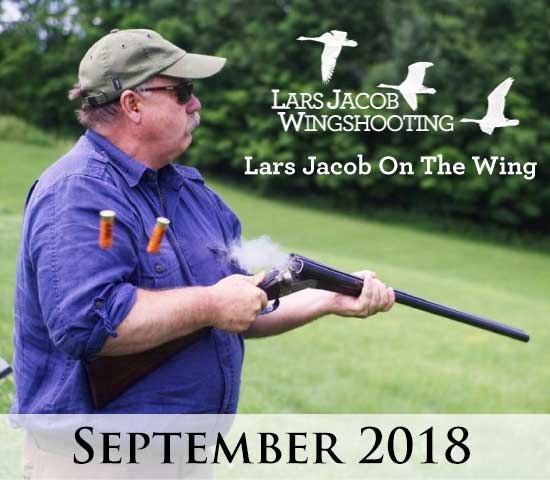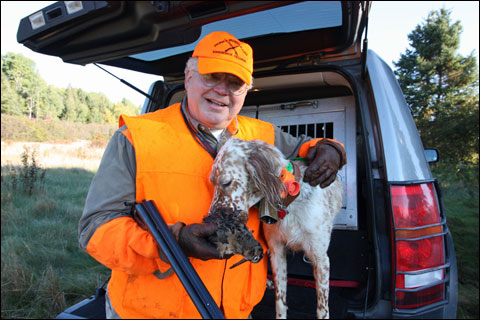How to Find the Holy Grail of Woodcock Shotguns

The Holy Grail of shotguns can mean many things. The driven bird shooter desires a break action with long barrels like a clays gun but stocked like a game gun. Dove shooters love their nimble sub-gauge auto loaders especially with the three round capacity. And of course the waterfowler needs the recoil taming and durability of a synthetic stocked cannon. In the Northern region our early bird seasons include a unique bird, the American woodcock. With their “here today, gone tomorrow” migrations, this article will discuss finding the perfect woodcock gun.
To the woodcock hunter the Holy Grail is a shotgun that is as dainty and acrobatic as is the little whimsical bird itself. Coverts filled with alder, hawthorns, popples and other young forest growth make the birds behave in a particular way. Woodcocks are light and quick and can easily change direction, and so our perfect woodcock gun needs to have the same attributes.

To pop off a snap shot before the bird darts behind a tree, woodcock shotguns tend to be light and lively.
A light gun is easy to carry, but more importantly it’s easy to switch between hands when pushing through cover to where you last heard the dog’s bell. Of primary importance, a light gun responds and moves more quickly with your eyes. Weight reduction can come from many factors. The first and most obvious comes when shooting sub-gauge guns. Twenty-gauge and 28-gauge shotguns are by far the most common choices because they have more than enough knockdown power for woodcock. But there are other, less obvious factors we can look for that help create a lively gun.
The use of alloys in the frame of modern guns has given new life in the advocacy of a 12-gauge. A 12-gauge hull with either a ⅞-ounce load (equal to a standard 20-gauge) or a ¾-ounce load (equal to an average 28-gauge) will do just fine. Guns with 2¾-inch chambers instead of 3-inch and fixed chokes are significantly lighter due to thinner barrel walls. And of course side-by-sides are considerably lighter than over/unders in the same gauge because they have less mass in the frame and barrels.

For Ed Belak, a good bird dog, nice cover and a proper-fitting shotgun make woodcock hunting a joy.
To some people, shooting a side-by-side shotgun can be intimidating. But many students who visit me to learn to shoot a side-by-side find them to be perfect woodcock guns. Shots taken on woodcock are close and quick snap shots. We are not using methodologies of swing-through or pull-away that are common in open fields or when pass shooting. Instinctive shooting is simply throwing your hands up into perfect alignment of your line of sight while you focus hard on the beak or eye of the woodcock. The straight-hand stock, typical of a side-by-side, help keep the hands from being staggered, and the splinter forend lays the barrels into the palm of the hand, which helps keep the gun aligned with the two hands. If you aren’t convinced, look for pumps and over-and-unders with thin combs, straight- or long-sweeping pistol grips, and small profile forends. All these will help lower the gun into the hands and enhance pointability.
A great place to look for the perfect woodcock gun is in the used gun market, especially early and vintage guns. Woodcock may be difficult to hit but they are easy to kill. The thin skin and light quills mean smaller shot size can be used, and fewer pellets are needed for an ethical kill. Early guns were built before there were an abundance of shells boasting ridiculous velocities and long-range energies, so there was less mass built into the barrels and lock-up creating light and lively guns.

Because of the density of young forests, shotguns, loads and chokes tend to be very specialized for woodcock hunting.
Older Beretta Silver Snipes, BL-3s and BL-4s, Miroku made Charles Dalys, and Zoli-and-Rizzini made Abercrombie & Fitch guns are all great choices at very reasonable prices. I shot my first woodcock with an Ithaca/SKB 200E in 1971. You can still find these great little guns. Pre-war Birmingham UK guns and vintage American guns are perfect as well, but with slightly stiffer price tags. One of the more common requests I get from my clients is for 16-gauge Parker VHS built on the light “0” frame; that model is a delightful little upland gun. And the best part about older guns is that you won’t have to show them how to hunt. They’ve been hunting for far longer than we’ve been alive. As new owners, we are just another chapter in their long existence.

While some wingshooters believe a side by side can be intimidating, many of the author’s students learn that it in fact the shotguns are great for hunting woodcock.
Barrel length has always been a big debate in describing the perfect woodcock gun, and some claim it to be the determining factor, but to me it will always be weight. Two of my favorite woodcock guns had 30-inch barrels. One was a 16-gauge Scott side-by-side that weighed 5 lbs./10 oz. The second was a Beretta 28-gauge that weighed 5 lbs./12 oz. Both guns performed flawlessly in the tight cover. The most important factor is the fit of the gun, so be sure to have your gun professionally fit. If you have a shotgun you shoot well, measure the dimensions and compare them with a new candidate. Shotguns are like Lay’s potato chips – you can’t just have one. My guess is you will end up with more than one perfect woodcock gun. And that’s not so bad, is it?
Unless Lars Jacob is running dogs, wetting a fly line or turkey hunting, everything he does revolves around shotgunning. Jacob has been teaching the finer art of wingshooting for over 30 years. He has run programs and gun rooms for the Dutch River Club, Covey & Nye and Orvis Company to name a few. Jacob is the founder and CEO of Lars Jacob Wingshooting, LLC and LJW Roving Syndicate. In addition to instruction, Jacob is recognized as one of the country’s finest gun fitters and recently worked with Perazzi’s Al Kondak to develop the Perazzi Ladies Sporter. He has a soft spot for side-by-sides and has introduced thousands of shooters to the nuances associated with shooting such shotguns. For more information visit www.larsjacobwingshooting.com.

Unless Lars Jacob is running dogs, wetting a fly line or turkey hunting, everything he does revolves around shotgunning. Jacob has been teaching the finer art of wingshooting for over 30 years. He has run programs and gun rooms for the Dutch River Club, Covey & Nye and Orvis Company to name a few. Jacob is the founder and CEO of Lars Jacob Wingshooting, LLC and LJW Roving Syndicate. In addition to instruction, Jacob is recognized as one of the country’s finest gun fitters and recently worked with Perazzi’s Al Kondak to develop the Perazzi Ladies Sporter. He has a soft spot for side-by-sides and has introduced thousands of shooters to the nuances associated with shooting such shotguns. For more information visit www.larsjacobwingshooting.com.


Comments